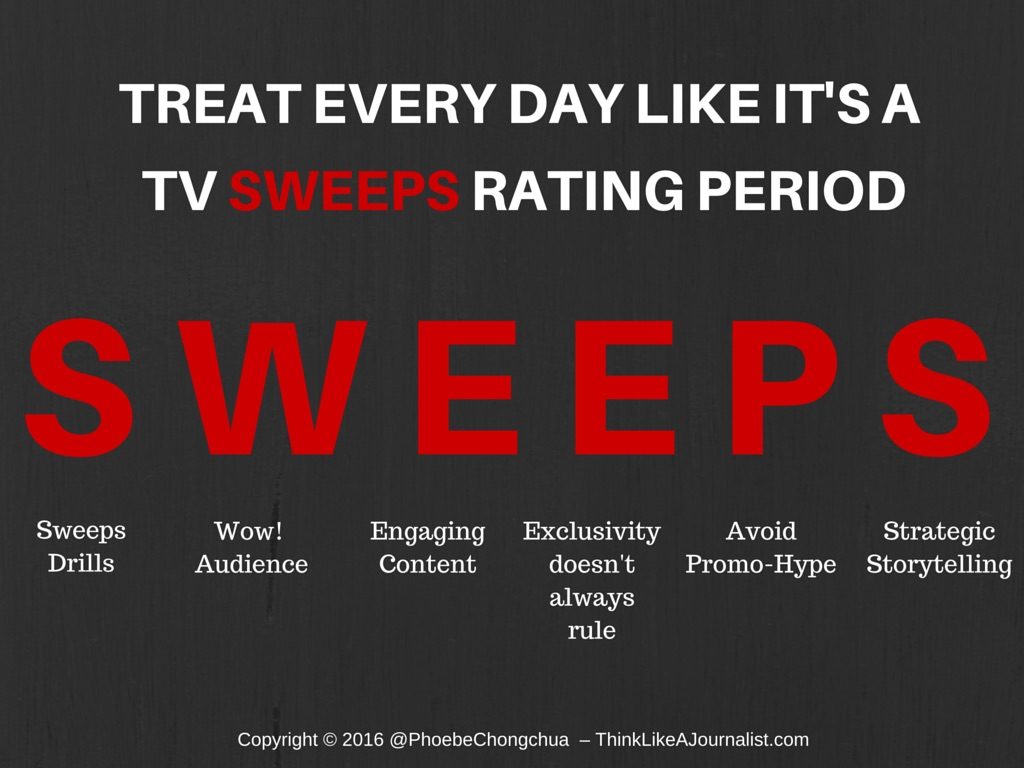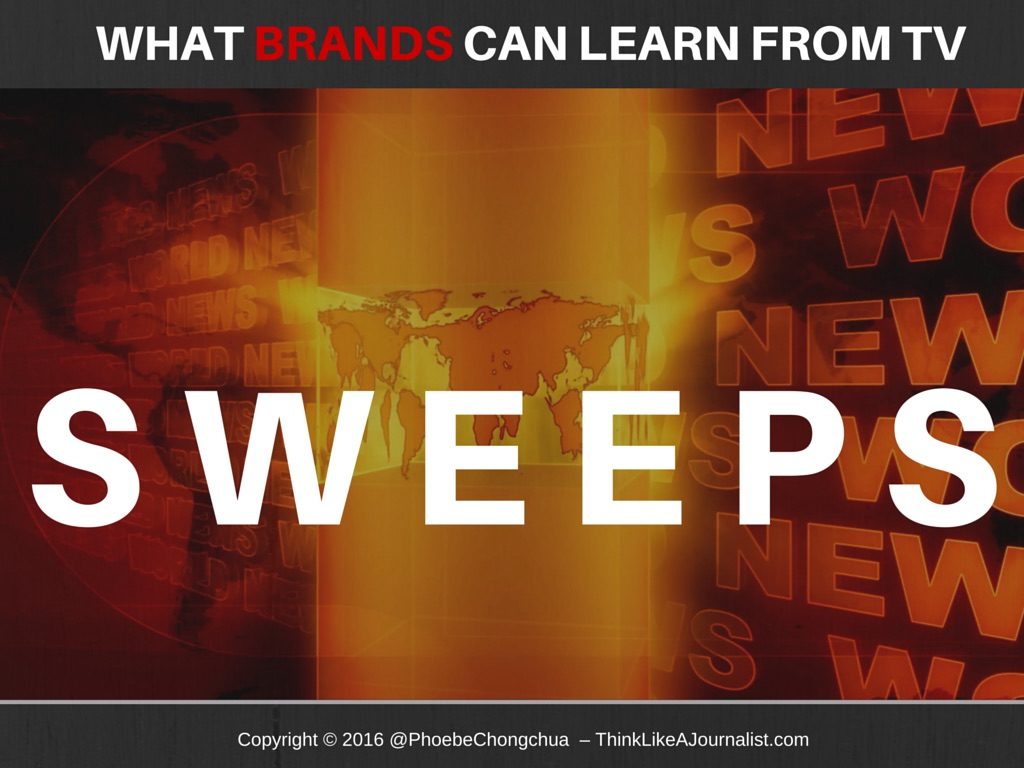Four times a year in the TV news industry since 1954 there is a short period of time when programming changes on TV. Viewers can usually spot this time even if they’re not really sure what it’s called and even if they never worked a day in a newsroom.
It’s a time when viewers start seeing even more sensational, dramatic, sexy, outrageous, controversial content on the airwaves.
Welcome to TV Sweeps. This rating period determines how much TV stations can effectively charge their advertisers who want to run commercials during specific newscasts, sports events, and TV programs.
It’s a very important period for the TV station. How the station stacks up during sweeps can make it a good or bad revenue year.
The key is getting significant viewership during sweeps; hence the sensational, dramatic, sexy, outrageous, and, controversial content.
But wait a minute…is that really what viewers want to see? Will that really increase viewership?
The news department thinks so. So, that’s what gets played up by the creative services department (the part of the station that comes up with those tantalizing promos you see for sweeps stories).
Generally, reporters working on sweeps stories will get extra time to spend on putting together the story. Instead of having to churn out two stories for the day’s newscasts, they might get several days or even a week or two to produce their sweeps story. After all, it’s a very important element to the sweeps rating period.
What brands can learn from TV sweeps periods.
A lot…especially from TV stations that are producing quality not sensational content during sweeps.
Since today every company can be its own media company (EC=MC), producing high-quality content and distributing it to its own homegrown audience, the answer is quite simple: treat every day like it’s a sweeps rating period.
That’s what the top TV stations do. They don’t wait until sweeps to start producing good stories…they do it year round and double-down during sweeps with even better stories.
And brands should do the same.
If your brand treats every day like it’s a sweeps rating period, you’ll put more effort into your content creation. You’ll work on telling better, more in-depth stories. You’ll work on producing stories that will interest and engage your audience. You’ll be keenly aware of the stories that matter to your audience because you know you’re being measured during this time.
This practice alone sharpens your news senses which is a valuable skill to learn especially if you want traditional media attention.
You’ll find that by taking action and deploying your team to focus on the content that can make a bigger difference to your online community will result in more views and greater retention of your audience.
Using brand journalism content distributed via your company’s own brand newsroom and social platforms can have a big payoff in the following areas:
- Brand awareness: your unique voice, told from your own brand identity. Increased traffic to website, thought leader positioning in the marketplace, go-to expert for media within your niche.
- Community engagement: builds know, like, and trust. Increases sharing of your brand messaging, builds loyal customers, and brand evangelists.
- Customer retention: increases email open rates, visit to your website, encourages conversation.
- Marketing collateral: excellent marketing tools for sales people to use to explain your brand, products, and services.
- Increased sales: greater return on investment, decreases cost of acquiring a new customer, increase close rate especially when sales and internal team use and refer to the brand journalism content pieces.
Remember though, that the brand journalism content you produce shouldn’t always talk about your brand. Instead it will focus on your community and it will share information and stories that make an impact on your audience’s lives. The content should be about things your audience is involved in and talking about.
Research first…produce content second.
The shift in focus off of your brand and on to your audience is a newsroom mentality that is drilled into journalists’ heads. This is why I teach brands to: Think Like A Journalist to tell stories that matter.
Developing a culture in your brand to treat every day like it’s sweeps will catapult your content to a new level. But the danger comes when brands look for a “viral” impact.
They get too cute with their content. They lose sight of their audience wants and needs. They look for the “get-rich-quick” in content marketing. These mistakes are no different from a TV station that aims to win sweeps rating periods with super cheesy and sensationalized content.
You know what I’m talking about… I can see you rolling your eyes or shouting at the TV set right now!
This is why so many people often make fun of the sweeps rating period. The stories have become more sensational in an effort to simply win viewers, even if only for a segment or two of an hour-long newscast. Often this is a signal that things are quickly heading south for that TV news station.
In the industry, the decline of a TV show is referred to as “jump the shark”–the moment that defines when a TV show has lost its quality and is heading downhill. The term was coined by Jon Hein in 1987 after the sitcom “Happy Days” ran an episode where Fonzi, on waterskis, jumps over a confined shark.
However, TV news stations that do it right during sweeps actually gain more viewers because the stories they tell aren’t sensational but are instead compelling and offer real value to their viewers’ lives. And when the competition is messing up, viewers make a fast switch to a different station.

Here are the top five ways TV news stations make their sweeps rating periods attract their core audience without having a “jump the shark” moment. You can remember these tips with this acronym: SWEEPS: Sweeps drill, Wow! you audience, Engaging content, Exclusivity doesn’t always rule, avoid Promo-hype, and be Strategic with your storytelling.
Sweeps drill: Run a modified sweep’s drill year round. Don’t let up on your content ever. Keep creating great content all year round. During certain timeframes when your content is especially critical, for instance, if you have a greater audience before, during, or after a trade show or convention, ramp up your content creation and create longer and more engaging pieces. Give away white papers or cheat sheets–something of value that will cause your viewers to visit your blog more frequently.
Wow! your demographic: Focus on a specific demographic. Know your audience so well that you can wow them by creating stories that matter to them. Aim to tell stories that resonate with that demo.
Create engaging content: produce in-depth content on high-impact topics. look for stories that will become potential influencers in marketplace trends, culture, or industries. Dig around to see which high impact topics your brand can share or produce content on that will matter to your core audience. Use “piggyback journalism” to jump on the back of a timely news story by inserting a different and unique perspective to the story. This will cause your story to be linked to the original story and allows it to “piggyback” on the current, real-time news story, leveraging attention by association.
Exclusivity doesn’t always rule: just because it’s exclusive doesn’t mean you have a great story. Some stories aren’t being told because they’re not worthy of coverage. Brainstorm your stories and then carefully research whether the stories on your list are really “sweeps-worthy” content.
Avoid promo-hype: don’t over sell and under deliver a story. If you sell a story idea to your board or C suite and then create the content on a topic that has no real story behind it, the story will fail with your audience. This is what you see happening in TV when you see an interesting promo spot but then are disappointed when you watch the actual TV story because it lacks the “meat” of the story. It just never was meant to be a story; it’s simply a a good promo.
Be strategic with your storytelling: stories that attract, engage, stimulate, make people laugh, provoke conversation, and/or change the world are the stories that are remembered, retold, and, shared. Your posted stories on social media platforms can create valuable synergy between social and search, providing great supplemental keyword information that attracts customers to your brand.
When you learn to extract the good aspects of a TV newsroom, you learn to develop a system and formula for hooking an audience, telling stories that matter, and producing content that helps your brand be found online.
For a deeper understanding of brand journalism, check out these episodes from The Brand Journalism Advantage Podcast.
TBJA 227 How Writing Attracts Clients, Linda Dessau
TBJA 209 How To Breakthrough The Noise With Your Marketing, David Murdico
